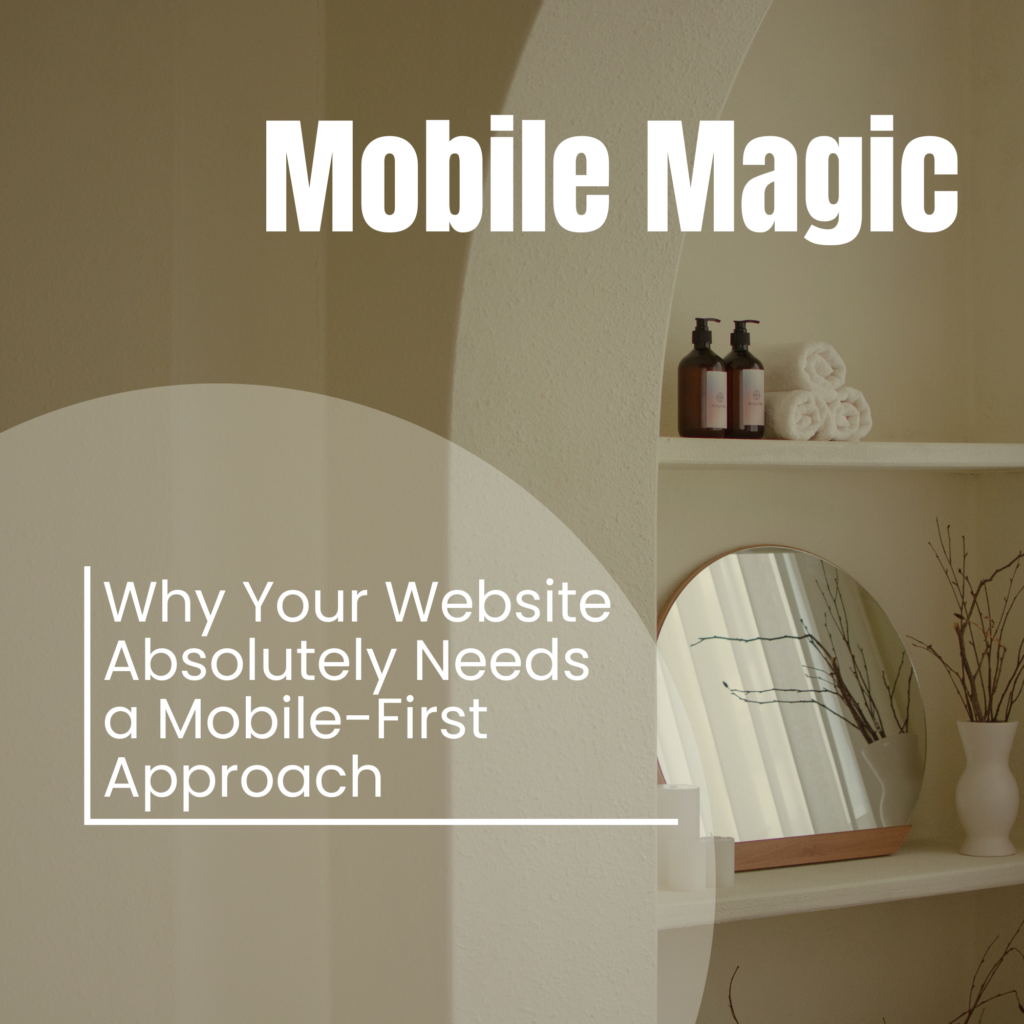The smartphone revolution has fundamentally changed how we interact with the internet. In 2024, it’s no longer a question of whether people use their phones to browse the web – it’s a certainty. In fact, statistics show that mobile browsing has surpassed desktop usage globally. This shift in user behaviour demands a corresponding shift in website design – enter the mobile-first approach.
But what exactly is mobile-first, and why is it so crucial for your website in 2024? Let’s delve into the magic of mobile optimisation and explore the benefits it offers to businesses of all sizes.
The Rise of Mobile Users: Why You Need to Prioritise Mobile-First
Imagine this: a potential customer searches for your business on their phone. They land on your website, but the text is tiny, the images don’t load properly, and clicking buttons feels like a frustrating game of chance. Frustrated and annoyed, they abandon your site and likely turn to a competitor with a mobile-friendly experience.
This scenario is all too common for websites that haven’t embraced mobile-first design. Here’s why prioritising mobile is no longer optional:
- Mobile Dominates Web Traffic: As mentioned earlier, mobile browsing has surpassed desktop usage. Studies indicate that over half of all web traffic globally now originates from smartphones and tablets. This means if your website isn’t optimised for mobile, you’re essentially ignoring a significant portion of your potential audience.
- Enhanced User Experience: Mobile users expect a seamless experience. A website that’s difficult to navigate, slow to load, or requires zooming and pinching to read text creates frustration and drives visitors away. Mobile-first design ensures a smooth and intuitive experience for users on their smartphones, keeping them engaged and more likely to convert.
- Improved Search Engine Ranking (SEO): Search engines like Google prioritise mobile-friendly websites in search results. This means a website optimised for mobile devices is more likely to rank higher in search results for mobile searches, leading to increased organic traffic and brand visibility.
- Faster Loading Speeds: Mobile users are impatient. They expect websites to load quickly and efficiently. Mobile-first design focuses on creating lightweight, fast-loading pages that provide a smooth browsing experience even on slower internet connections.
- Boosts Conversions and Sales: A user-friendly mobile website makes it easier for customers to take desired actions, such as making a purchase, contacting you, or subscribing to a newsletter. This translates to increased conversions and ultimately, boosts your bottom line.
The Magic of Mobile-First Design: Key Components for Success
So, how do you create a website that prioritises mobile users and unlocks its potential? Here are the key components of a successful mobile-first design:
- Responsive Design: This is the foundation of mobile-first. Responsive design ensures your website automatically adjusts its layout and elements to fit different screen sizes, from large desktops to small smartphones. Images resize, text remains readable, and navigation remains intuitive regardless of the device used.
- Prioritise Simplicity: Mobile screens are smaller, so information overload is a recipe for disaster. Focus on clear and concise content, prioritise what’s most important, and ensure menus and buttons are easy to find and tap.
- Fast Loading Speeds: Nobody wants to wait for a website to load on their phone. Optimise your images, minimise code bloat, and utilise caching techniques to ensure your mobile website loads quickly and efficiently.
- Thumb-Friendly Navigation: People navigate with their thumbs on mobile devices. Design your navigation buttons and menus with ample space for easy tapping, avoiding clutter and frustration.
- Large, Readable Fonts: Tiny text squinting on a small screen is a surefire way to lose visitors. Use large, easy-to-read fonts with sufficient contrast for optimal readability on mobile devices.
- Click-to-Call Functionality: Make it easy for mobile users to contact you with a click-to-call button. This eliminates the need for them to manually type your phone number, streamlining the communication process.
- Prioritise Local Search Optimisation (SEO): If you have a brick-and-mortar location, ensure your website is optimised for local search on mobile devices. This includes clear address information, integration with Google Maps, and highlighting location-specific services.
Beyond the Basics: Advanced Mobile-First Strategies
While the foundational principles are crucial, there’s more to mobile magic than just responsive design. Here are some advanced strategies to further enhance your mobile website:
- Leverage Accelerated Mobile Pages (AMP): AMP creates lightweight versions of your webpages specifically optimised for mobile devices. This can significantly improve loading times and user experience.
- Implement Mobile-Specific Features: Consider features that cater specifically to mobile users, such as geolocation services for location-based content or click-to-order functionality for restaurants or e-commerce businesses.
- Optimise for Voice Search: As voice search becomes increasingly popular, optimise your website content with relevant keywords and long-tail phrases that users might use in spoken queries.
- Utilise Mobile App Integration: For businesses with mobile apps, consider integrating them seamlessly with your website. This can allow users to easily download the app directly from your mobile website or access app features within the mobile browser.
- Invest in Mobile Marketing Strategies: Mobile advertising and targeted campaigns can be highly effective in reaching your target audience. Explore options like SMS marketing, social media advertising with a focus on mobile users, and location-based advertising to reach customers on their phones.
- Track and Analyse Mobile Metrics: Don’t just build it and forget it. Use website analytics tools to track key metrics specific to mobile users, such as mobile conversion rates, time spent on mobile pages, and bounce rates. This data can help you identify areas for improvement and optimise your mobile website for even better performance.
Mobile Magic: The Key to Success in a Mobile-First World
In conclusion, a mobile-first website design approach is no longer a luxury, it’s a necessity for businesses of all sizes in 2024. By prioritising mobile users and crafting a website that offers a smooth, intuitive, and fast experience, you unlock a world of benefits. From increased traffic and improved search rankings to higher conversion rates and a more positive brand image, mobile-first design empowers you to connect with your audience on their terms and drive success in the mobile-first world.
Embrace the magic of mobile! Invest in a mobile-first website and watch your brand flourish in the ever-evolving digital landscape.





